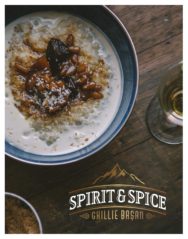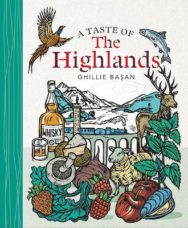‘The aromas and flavours, the company and location, can all add to the dreams and storytelling; it is, after all, a drink of friendship and hospitality.’
The pleasures of food and drink are always worth celebrating whatever the season, and leafing through the many treats in Ghillie Basan’s latest book will provide a whole lot of inspiration in spoiling yourself, while sharing stories of the many wonderful food locations in the Highlands. How lucky we are to have all this on our doorstep!
Extracts taken from A Taste of the Highlands
By Ghillie Basan
Published by Birlinn Ltd
Traditional Highland Cranachan
Cranachan is a traditional soft fruit brose, which was once a dish of celebration, particularly at harvest time. In some crofting households the fruit and cream were put on the table and everyone made their own mix adding whisky and honey. Sometimes a charm or a ring would be put at the bottom of the oatmeal brose – the person who found the ring would be the next to get married, or the charm might bring good fortune.
Also called ‘cream-crowdie’, the cranachan of my teenage years wasn’t nearly as exciting – only appearing on Burns Night, made with sludgy crowdie cheese that tasted like it been strained through someone’s unwashed tights and raspberries out of a tin! It was enough to put me off it for life – until one day a mouthful of creamy, nutty oatmeal, lightly laced with whisky and heather honey, topped with fresh, sweet raspberries from Blairgowrie made absolute sense. Nowadays, cranachan is regarded as a national pudding, served all over the country at any time of the year and the recipe has evolved to include whipped cream, yoghurt and a variety of cream cheeses and fruits. It is very much a dish that is prepared according to taste, particularly the ratio of oatmeal to cream and the measurement of a good dram. In this recipe I have tried to stick to the traditional whisky-soaked brose but lightened the layers with a puff of whipped cream. This is the way we enjoy it in our home. With three great Highland products – oatmeal, raspberries and whisky – it could be said that this is the Highlands in a bowl!

Tip most of the toasted oatmeal into a bowl – keep back 1 tablespoon for the top – and pour in the cream and whisky. Leave the oatmeal to soak it all up for at least 2 hours. Stir in the honey and add more whisky or cream to your taste. The mixture should feel quite light but the oatmeal will still have a chewy bite to it.
In a separate bowl, whisk the cream to light, frothy peaks and fold in a little sugar, if you like. Select glass bowls or glasses for serving and layer up the cranachan, starting with the soaked brose, followed by raspberries, more of the brose, whipped cream, top with raspberries and finish with the reserved toasted oats. Gently beat in honey and whisky to taste. Spoon the mixture into a serving bowl and top with fresh raspberries.
Serves 2–3
5 tbsp pinhead or medium
oatmeal, toasted in the oven
8 tbsp double cream
2–4 tbsp whisky (I use a local Speyside one)
2 tbsp heather honey
150ml cream, for whipping
1 tsp sugar (optional)
fresh raspberries
Bramley Apple, Beetroot and Heather Honey Crumble
(Nethybridge)
At Dell of Abernethy, Polly Cameron puts on the kettle, stokes the fires and props up the kitchen stove, stirring glorious soups and stews with the luring aroma of a cake baking in the oven while she waits for the return of her guests from woodland walks and wild swimming spots. She and her husband, Ross, are passionate about offering true Highland hospitality and making their guests feel welcome. The property, which has now been in Polly’s family for four generations, is situated right on the edge of the Abernethy Nature Reserve in the Cairngorms – the perfect location for the team from the BBC’s Springwatch to set up camp and present the show from the large canvas tipi usually reserved for yoga, fitness, dance, weddings and music gigs.
Previously Polly and Ross had run a successful restaurant, the Ord Ban, in Rothiemurchus so when they took over Dell of Abernethy eight years ago they brought with them their cooking and hosting skills to provide a nurture element to the retreat with carefully planned menus showcasing local growers, producers and artisans. They also grow as much as they can in their organic garden, turning gluts of herbs into pesto and steeping autumn fruits in whisky to make liqueurs. The apples shaken from the trees often end up in delicious and unusual crumbles like this one.
Preheat the oven to 180°C (fan 160°C), 350°F, gas mark 4.
In an electric blender, whizz the cooked beetroot with the honey and nutmeg until you have a smooth purée. In a bowl, combine the purée with 50g of the demerara sugar and toss in the cubed apple.
Pack the mixture tightly in a deep ovenproof dish, allowing a few centimetres for the crumble topping.
To make the crumble, pulse the remaining sugar, flour, butter and oats in a food processor or rub together by hand until a good crumble consistency.
Cover the apple mix completely and bake for about 45 minutes, until the crumble is golden brown and the apple is tender. Serve with cream, yoghurt or vanilla ice cream.
Serves 4
2 small cooked beetroot,
cooled and skinned (approx. 150g)
1 large dessert spoon of heather honey
½ tsp grated nutmeg
125g demerara sugar
3 large Bramley apples, peeled, cored and cut into 2cm cubes
75g plain flour
75g butter
75g rolled oats
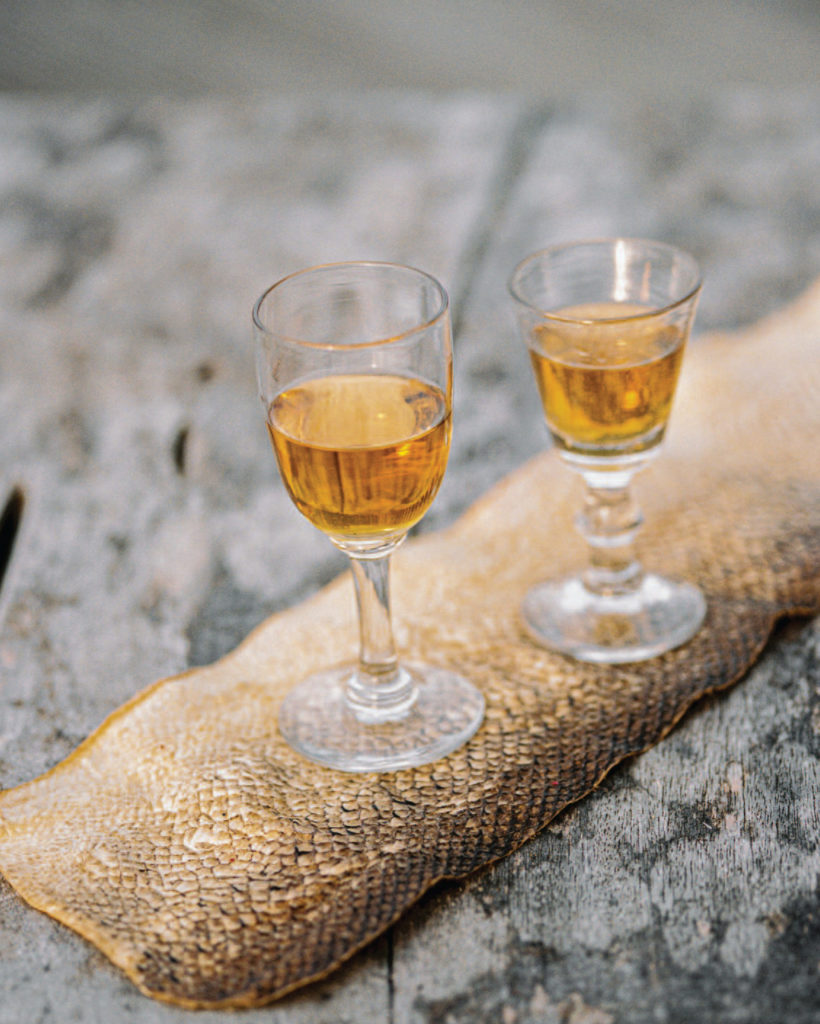
Highland Whisky
The word ‘whisky’ derives from the Gaelic uisge beatha (pronounced ‘ooshky bay’), meaning ‘water of life’ and for many Highlanders that is exactly what it is – life is good if there is whisky in the house. Some swear that a dram a day will see them through good health and old age. My nearest neighbour in a croft at the end of the glen ‘will die happy if he has a dram in his hand’, indeed my own father reached the grand age of 91 and his parting breath was enriched by a final dram.
Since the fifteenth century, whisky has been part of life in the Highlands, embroiled in illicit distilling and smuggling, evading excisemen and taxes. At one time whole communities were involved in either making whisky or smuggling it – the subject of myths and legends and the catalyst of many a story. I live in a whisky smuggler’s glen where over the years the tales of illicit stills and excisemen buried in peat bogs have grown congenial arms and legs but that is part of the spirit’s hypnotic pleasure. The aromas and flavours, the company and location, can all add to the dreams and storytelling; it is, after all, a drink of friendship and hospitality.
The Highland whisky region includes Orkney, the Western Isles and parts of Perthshire and Aberdeenshire. Within the boundaries of this book, though, we start at the foot of Argyll in Campbeltown with Springbank Distillery, the only distillery in the Highlands to do all its own malting, distilling, maturing and bottling on site, head up to Thurso to Wolfburn Distillery, the most northerly on the mainland, and we include Speyside, the biggest whisky making region in Scotland, where the modern Scotch whisky industry was born. The Highland whisky region is vast, characterised by diverse landscapes, geology, weather conditions, water sources, soil and vegetation, all of which bear some impact on the flavour of the whisky or the style of a particular distillery. The commonality is in the process – the malting, fermenting, distilling and maturing – but the singularity of whisky, the complexity of flavour and texture, the finish on the palate, is rooted in the location, the decision-making of the distiller, and time. Whisky is a creature of the land and time.
Should you drink whisky neat, with water, or on ice? I have worked with so many whisky groups from different parts of the world that I have learned that best way to enjoy whisky is to drink the one you like, the way you like it. But there is nothing quite like the enjoyment of a dram in its natural environment: the mist softly falling down the mountain slopes, miles of peaty moorland peppered white with wild cotton, little green lochans and the purplest heather you have ever seen, lashing rain followed by bursts of sunlight catching every droplet of water on the leaves and trees, horizons you never quite reach and silence that you can hear. Your cheeks feel tight and cold as your warm breath floats in the chill air, but when you nose that glass warming in your hands the aromas of larch and pine and coconut-scented gorse, heather honey and meadowsweet, smoky peat and salty air, even the fruity smell of the dung being spread to fertilise the fields, will fill your senses as you tip the dram to your lips to taste. A Highland dram in the Highland air – we’re back to where we started this the book with the goût de terroir!
Slàinte mhath!
A Taste of the Highlands by Ghillie Basan is published by Birlinn Ltd, priced £25.00
ALSO IN THIS ISSUE
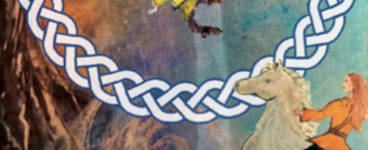
 The Shanter Legacy
The Shanter Legacy
‘”Our world is about to change, my dears. We will have to survive as best we can.”’
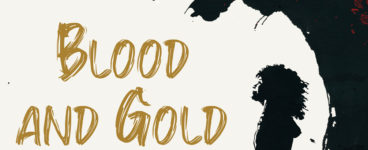
 Blood and Gold
Blood and Gold
‘She heard of talking chickens, eagles with sparkling, vibrant feathers and a magic needle to whom t …





